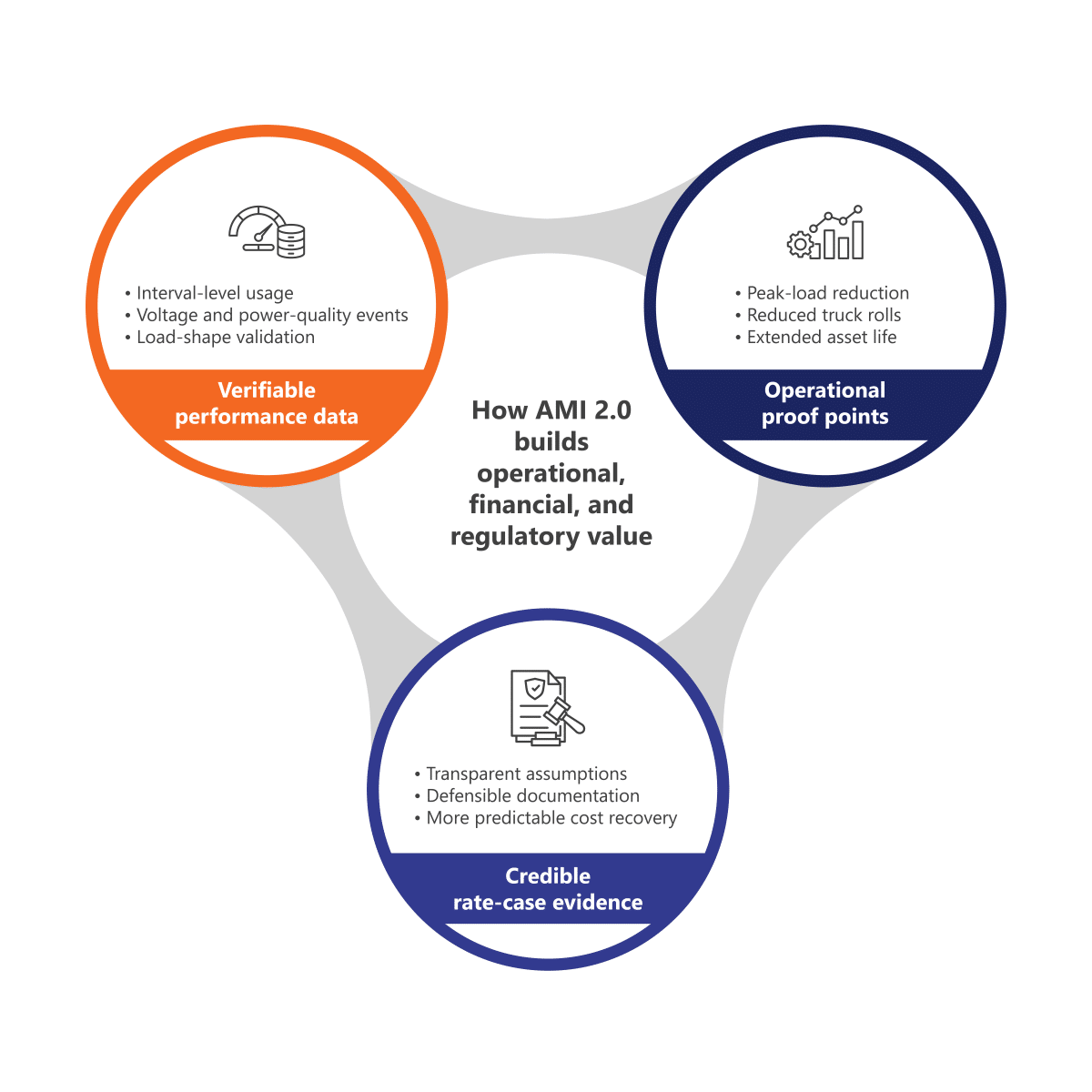Executive summary: AMI 2.0 is redefining how utilities demonstrate performance, manage regulatory requirements, and validate investment outcomes. High-fidelity data from advanced metering systems strengthens rate-case filings, supports compliance obligations, and clarifies the operational impacts of modernization efforts. Together, these capabilities position AMI 2.0 as a critical enabler of regulatory confidence and long-term financial value.
3-minute read
Across ongoing grid modernization efforts, investment is shifting beyond meter upgrades and toward the latest evolution of advanced metering infrastructure (AMI 2.0). AMI 2.0 delivers more than two-way communication. It captures high-resolution consumption, voltage, and grid-health data. The system also ties into enterprise tools such as OMS and CIS to support efficiency gains and emerging regulatory requirements.
For utility leaders, this evolution creates a twofold opportunity. AMI 2.0 enables stronger compliance with rising transparency and performance requirements, while also supporting business cases grounded in measurable, data-driven results. The granular insights and real-time visibility from AMI 2.0 make it a strategic foundation for regulatory confidence and long-term ROI.
Building regulatory credibility through AMI 2.0 insights
Regulators increasingly expect utilities to show clear performance and transparency, particularly in reliability and outage management, with added scrutiny around pricing and DER integration. Regulatory priorities now encompass metrics such as SAIDI and SAIFI and extend to areas including outage validation, dynamic pricing, DER oversight, and efficiency-program verifications.
AMI 2.0 provides a verifiable stream of operational insight: interval-level visibility into system performance, customer behavior, and real-time grid conditions. According to the 2024 Federal Energy Regulatory Commission (FERC) Assessment of Demand Response and Advanced Metering, national AMI penetration reached 72.3 percent in 2022. Widespread deployment now enables utilities to provide interval-level usage, voltage, and power-quality data at a scale that aligns with today’s regulatory expectations.
High-frequency meter data helps validate load patterns and energy-savings estimates, and it can confirm reductions in peak demand. These insights support compliance with program-participation rules and help utilities prepare rate-case filings that stand up to scrutiny.
As DER adoption accelerates, AMI 2.0’s ability to capture bi-directional flows and power-quality events gives operators clearer visibility into system behavior. Greater visibility helps utilities meet performance standards set by regulators and other stakeholders, including DER providers.
Article continues below.

White paper: Unlocking the ROI of AMI 2.0
A strategic approach to prioritizing use cases for maximum impact
We will never sell your data. View our privacy policy here.
Strategic implications for utility leaders
For executive teams and boards, AMI 2.0 is not just a meter-deployment initiative but a foundational data layer that supports modern operations, strengthens regulatory alignment, and informs long-range planning. The resulting value shows up in three key areas:
- Compliance confidence, backed by trusted data and analytics that help utilities anticipate regulatory needs
- Operational leverage, as higher-fidelity data strengthens process optimization and reduces field effort
- A strong financial case, supported by clear performance metrics and documented cost-avoidance results
Together, these outcomes position AMI 2.0 as a strategic enabler of regulatory credibility and broader enterprise value.
Article continues below.

The next frontier: AMI 2.0 as a driver of enterprise foresight
AMI 2.0 data is reshaping how utilities substantiate value in regulatory settings. Interval-level evidence strengthens rate-case filings on load shapes and efficiency-program impacts, grounding claims in verifiable performance rather than modeled assumptions. The resulting foundation reduces uncertainty for regulators and supports more predictable cost recovery.
The same data environment expands what utilities can validate operationally and allows teams to quantify avoided costs—such as fewer truck rolls—along with asset-life extension and peak-load reduction with greater precision. These insights reinforce the financial elements of the business case and show how operational improvements turn into measurable outcomes.
In a landscape where regulatory expectations continue to expand and capital needs are becoming more complex, utilities that view AMI 2.0 as both a regulatory and operational asset are gaining an edge. Consistent, credible demonstration of measurable impact will influence how effectively they secure approval, maintain stakeholder confidence, and deliver long-term ROI.
References
https://www.wwdmag.com/what-is-articles/article/10940067/what-is-advanced-metering-infrastructure-ami
https://www.ferc.gov/sites/default/files/2024-11/Annual Assessment of Demand Response_1119_1400.pdf
https://opc.maryland.gov/Consumer-Learning/Electricity/Smart-Meters
https://www.german-metering.com/advanced-metering-infrastructure-ami.html
https://blog.purestorage.com/purely-educational/what-is-ami-data-and-how-can-utility-companies-benefit-from-it/
You might also be interested in …

Webinar: Making AMI 2.0 work
Explore how utilities turn AMI 2.0 investments into measurable benefits through clearer strategy, stronger data foundations, and proven operational and financial outcomes.

AMI 2.0 and DERMS: A powerful combination
Learn how integrating AMI 2.0 with DERMS enhances grid visibility, voltage management, and operational control as utilities expand distributed energy resources.

DERMS: Essential strategies for implementation
A practical look at the data, systems, and integration strategies needed to implement DERMS successfully and support evolving grid modernization goals

Turning AMI data into strategic advantage
- AMI strategy and roadmap development
- Value and benefit realization
- Data platform readiness and integration
- Advanced analytics and forecasting
- Pilot design and deployment support


